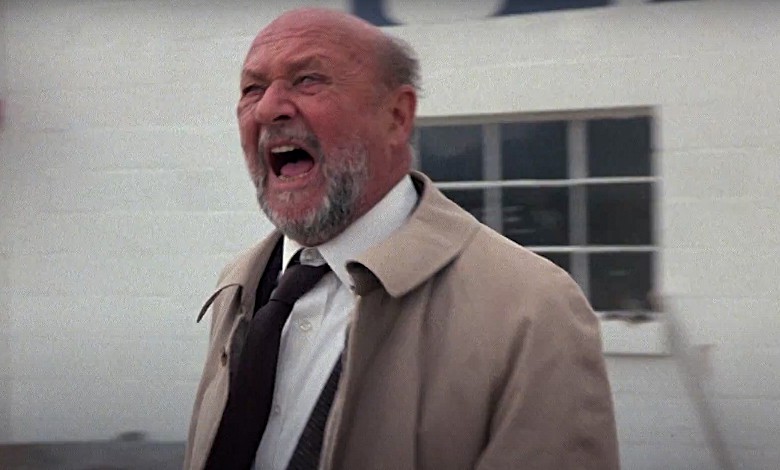
Dwight H. Little’s “Halloween 4: The Return of Michael Myers” gives us the title card of “October 30th, 1988” before the opening credits even begin and quickly announces that the film’s star isn’t simply Donald Pleasance but The Shape himself.
Myers was absent from the once despised, now more appreciated “Halloween III: Season of the Witch” (1983), which has become the reappraised cult favorite of this franchise.
In the late ’80s, however, “Season of the Witch” was perceived as a middle finger to the fanbase (as opposed to a radical shift of format). The fans wanted Myers back, as well as Pleasance’s Dr. Loomis, the shudder-inducing theme music from John Carpenter and (eventually) Jamie Lee Curtis’ Laurie Strode.
The fourth “Halloween” was announced as a return to form and, for the most part, delivers on that promise. Little’s film arrived deep into the slasher movie cycle – Freddy was four movies in, Jason was on installment number seven, Norman Bates had three movies and Chucky was debuting the same year.
In “Halloween 4: The Return of Michael Myers,” The Shape has survived and is ascending on Haddonfield, Illinois, and so has Dr, Loomis, both scarred from the explosion at the end of “Halloween II” (1981).
Now, Myers is drawn to his niece, Jamie (Danielle Harris, in her film debut), whose mother is the late Laurie Strode (Curtis, seen only in a photograph). Jamie lives under the protection of her foster family, particularly Rachel (an appealing Ellie Cornell) who acts as an older sister.
Once Myers shows up, it seems that no one can protect Jamie, or even stay alive long enough to try.
FAST FACT: “Halloween 4” hardly rocked the box office back in 1988. The film earned $17 million in U.S. theaters, but that figure tripled its $5 million budget. The previous sequel, which deviated from the Michael Myers storyline, earned $14 million in 1982.
Little’s 1988 film was the best of this era of the series, where Strode was absent (due to Curtis’ newfound career as an in-demand comedic actress) and Jamie and Loomis provided the human center. Some of this can feel mechanical and needlessly gory (clearly the lessons of “Season of the Witch” weren’t entirely taken into consideration).
Helping things a great deal is how strong Harris is – this is an exceptional performance for someone so young. Pleasance still gives his role his all, but Harris’ work cuts the deepest.
Logic comes and goes on a scene-to-scene basis, such as how Myers can survive just about anything and, despite being under wraps for a decade, can drive like a Hollywood stuntman.
The level of gore leans into the genre’s expectations and goes further than Carpenter would have a decade earlier. Nevertheless, Little’s film is mean, scary and suspenseful.
This is the strongest of the three Loomis/Jamie episodes, as the following “Halloween 5: The Revenge of Michael Myers” (1989) and “Halloween: The Curse of Michael Myers” (1995) ended up, at best, interesting failures.
Prefunk for the #HalloweenHoedown with the classic.#NowPlaying Halloween 4: Return of Michael Myers! The new 4K collectors edition. BOO🎃🎃🎃🎃 pic.twitter.com/1Z9e6SvTmY
— 300DaysOfHorror (@300Horror) October 9, 2021
This is the best film from Little, who later directed the ambitious Robert Englund-led “Phantom of the Opera” (1989), the Steven Seagal vs. killer Jamaicans bonce cruncher “Marked For Death” (1990) and Brandon Lee’s first starring vehicle, the middle of the road “Rapid Fire” (1992).
Little’s approach to a Halloween movie results in a different look from Carpenter (Walter Hill collaborator Ric Waite is skillful but misses the color schemes of original cinematographer Dean Cundey).
Yet, even though it screws up by not opening with a pumpkin carving montage (!) and includes a mob of rednecks taking on Myers (!!), Little’s film is atmospheric and tells its pulpy tale well.
A third act stalk n’ slash leads to a gripping rooftop chase, then a mechanical car chase and into a mine shaft tumble that never felt like much of a climax. Just when you think “Halloween 4” is wrapping up, we get its true legacy – a final scene that is so punishing, jolting and truly shattering, it rejuvenates the entire film.
In fact, the powerful closing moment is so good, the lesser subsequent sequels avoided addressing it altogether. No matter, as this unforgettable closing shot is not only the ace up the film’s sleeve but a perfect full-circle moment for the franchise.
Little didn’t just reverse the reception of “Halloween III” but concluded a better-than expected sequel with the kind of shock that matches the terror of Carpenter’s original.
Bravo.
